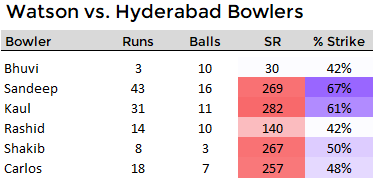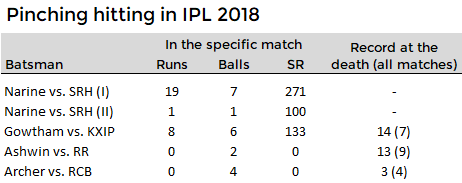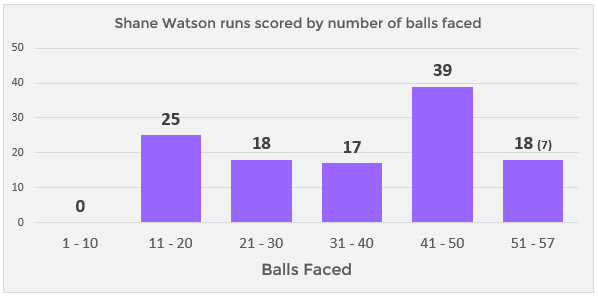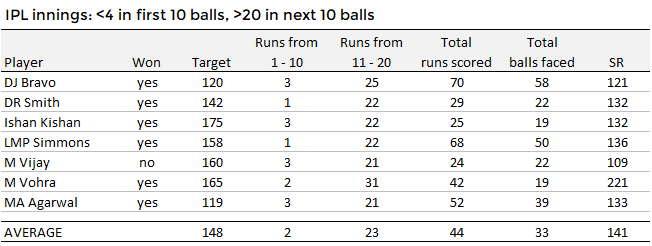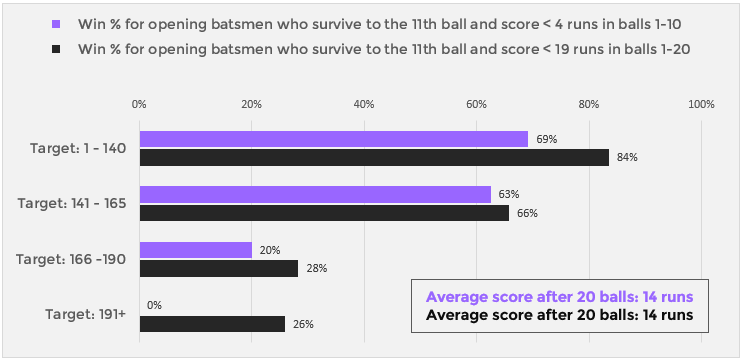Pinching in an IPL Final
It's rare to witness an innings that exhibits such a clear structure. Shane Watson's century in the IPL Final against Sunrisers Hyderabad was an extraordinary innings. He failed to score from the first 10 deliveries yet finished with a 205 strike rate. To some extent, the game-plan looked ingenious because Watson was able to execute so perfectly, but it was remarkable to see him so deliberate in deciding which overs to attack. Whether by design or simply the way events played out, it was special
Hyderabad had two world-class bowlers in Bhuvneshwar Kumar and Rashid Khan, the former looking particularly threatening during the first few overs of the match when the ball was swinging. Watson took few risks against these bowlers. He scored at a rate of 30 against Bhuvi and 140 against Rashid... compare that to a combined 270 against the other four bowlers!
It is worth emphasising that this is atypical. Bhuvi and Rashid are often the most economical bowlers in their team but the disparity is never that extreme. Watson was also more likely to sneak off strike when he was facing those two. Despite playing out a maiden over to start the match, he still only faced 42% of the deliveries from Bhuvi and Rashid. He faced 60% of deliveries from the other four bowlers, maximising his opportunities to score boundaries
Whilst watching, my thoughts turned to pinching, how Chennai Super Kings could have better used the first 10 balls of Watson's innings. At it's core, Shane Watson's game plan was about understanding that his wicket was extremely valuable. Early wickets are more valuable than late wickets, because they are often the best batsmen. In a previous article, I explained why openers do not necessarily need to be super fast starters - it is more important that they stay in the game. Unfamiliar pitches and swinging balls make this tough. Players like David Warner are so valuable because they consistently survive the first few overs whilst also scoring at a decent rate
But the other way to avoid losing your best batsman is not to send them out in the first place. Send out the bowlers. Chennai had 8 wickets remaining at the end of their chase against Hyderabad - plenty to spare. In the IPL, batsmen 7-11 face just 10% of deliveries. Most of the time they aren't needed at all and they would be needed even less if teams played them upfront and lengthened the batting order that way
In two games against Hyderabad as an opener, Narine scored 20 runs from 8 balls against Bhuvi's bowling. He was more willing to risk his wicket than Watson, safe in the knowledge that it was a much less valuable commodity than the wicket of a typical opening batsman. Other, less well-established pinch hitters in IPL 2018 managed 8 runs from 12 balls... even that is an improvement on nothing at all
Chennai had many options. They should be able to rely on Willey, Bravo or Jadeja to do the job that Gowtham, Ashwin, and Archer did for their teams. It is not a guaranteed success (as Ashwin and Archer proved) but the risk is minimal. Watson scored zero from his first 10 deliveries, believing that better opportunities were around the corner. A pinch hitter will usually beat zero
Some might argue that defending the first 10 balls helped Shane Watson to get set - but the progression of his innings suggests that the bowlers dictated when he scored, not his time at the crease. He did not get progressively faster and faster throughout the innings. For the first 10 balls, both Bhuvi and Sandeep looked dangerous. For the next ten, he scored freely once the ball had calmed down and he was facing weaker bowlers with fielding restrictions still in force. He then slowed down when Rashid entered the attack from balls 20-40 and finally accelerated again when Sandeep, Carlos and Kaul returned for their final overs
I looked for other occasions in IPL history when players started extremely slowly without losing a wicket. If you do exactly what what Watson did... your team usually wins. I looked for innings where the batsman scored fewer than 4 runs from the first 10 balls, and more than 20 from the next 10 (like Watson). There were 7 such occasions and the batsman ended on the winning team in 6 of the 7 matches (86% win percentage). But starting so slowly is not usually a winning strategy
These innings only represent the times when the strategy was successful. What about the times when the player failed to accelerate or was dismissed early? I also looked for openers who started slowly and survived until the 11th ball, but with no restrictions on how many they scored from that point onwards. These guys were much less successful - the average complete innings was 25 from 26 and their teams won just 48% of the time
As a benchmark, I then compared them to innings where the opener survived until the 11th ball and scored a similar number of runs, but with the runs more evenly distributed throughout the first 20 balls (rather than accelerating after a quiet start)
In both samples, the average score after 20 balls was 14 runs - not ideal - with the vast majority of those 14 runs coming after the 11th ball in the first sample. Overall, those teams with the slow starters were less successful. Chasing high targets or low targets, the win percentage was lower than for the teams where the opening batsman got started right away. There could be any number of explanations for this but, if nothing else, it suggests that defending the first 10 balls has little benefit towards the batsman getting 'set'. Despite rapid acceleration during the Powerplay, the slow starters were not able to maintain their increased scoring rate into the remainder of the innings
None of this is to say that Chennai had the wrong strategy against Hyderabad in the final. It is hard to watch Watson's phenomenal performance and say that he had the wrong strategy. But it probably shouldn't provide a standard template for other teams to copy. The situation was relatively unique - Bhuvi and Rashid form a two-man unit that few teams can emulate - attacking selectively was a good idea
The thing to remember is that there was an element of risk to the strategy, which is easy to forget in hindsight. Even after facing 30 balls, my numbers suggest that Watson would not have played a positive innings if he were dismissed on the next ball. No player had previously scored a century after failing to score from the first 10 deliveries faced - the record was 27 by Yogesh Takawale
Pinching provides a much less risky alternative to retaining key wickets in a dangerous period of a T20 innings. The Powerplay is the time when scoring runs is easiest but it is also the time when a swinging new ball is most dangerous. Sending in the pawns allows teams to achieve the best of both worlds. There is little evidence that defending the opposition's best bowler has any lasting 'get set' benefit. If a player wants to play safe and learn the pitch then they should do it in the quiet middle overs when the fielding restrictions are over. Pinch for the win
